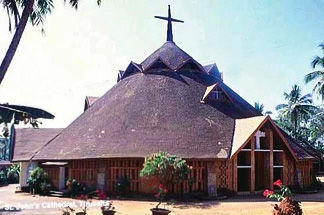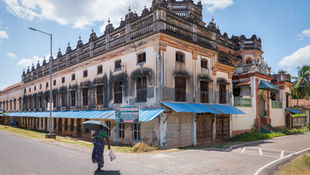Designing a Church is never an easy task. One has to not only think about the religious sentiments involved but must also be able to add his/her personal touch as an architect to make the project unique. I was given the opportunity to work on an upcoming Methodist Church project. Since we were at the beginning stage, I was given the task of research on Methodism and Church Architecture. During my research, I learnt a lot about Methodism, Christianity and Church Architecture that left me fascinated.
List of Contents
How is Methodist different from Christianity?
Methodism started in the early 18th Century as a movement, by John Wesley. The key features that set it apart were that it was preached in the open air and stated that the final authority in all matters of doctrine was the bible. In 1784, during the American Revolutionary War, due to the shortage of priests in American colonies, Wesley ordained preachers for America with the power to administer the sacraments. This was a major reason for Methodism’s final split from the Church of England.
Evolution of Churches
Churches are always known to be magnificent structures. The quality and level of detailing that go into creating a specific environment and space within are immense. I’ve read about and seen in pictures, great churches such as St. Peter’s Cathedral in Rome, St. Paul’s Cathedral in London, etc. Looking at photographs, I found one thing to be common amongst many churches; the sheer grandiose structure and its scale and proportion. They were initially very humble house-like structures, called Meeting Houses, and evolved alongside the crystallization of the definition of Christianity.
Church Design
The structure is usually designed having the altar on the East, although, in the past, many theories have played a role in other orientations. St. Peter’s and St. Paul’s originally had the apse placed in the western extremity. One of the reasons for this was to illuminate the altar with the light of the rising sun, by placing a large window at the opposite end. Churches were sometimes oriented towards Jerusalem as well. It is believed that the Jewish custom of fixing the direction of prayer and orienting synagogues, influenced Christianity.
The design of a church is meant to make a person who enters, feel a certain way. Regarded as the place of God, you are expected to maintain silence. Now, in most churches, this requires no effort. One is immediately noiseless when he/she steps into the aisle and faces the altar. I learnt that many aspects of church architecture are directly related to the church goer’s experience when inside the structure. For example, it is not very difficult to notice that the altar is usually the part of the church that is most brightly lit, while the pews are usually dimly lit.
This is to lay emphasis on the altar which is the focal point in a church. In some churches, a heavenly glow is created around the altar to elevate the feel of closeness to god. Tadao Ando’s famous Church of Light is a great example of a contemporary church. He simply created a cross-shaped opening behind the altar, to let in light. This being a source of light for the interiors, also has an intended radiance that makes it the numinous focal point.
Symbolism in Churches
Churches were traditionally designed and built strongly supported by symbolism. Every detail on an architectural feature would hold greater meaning. Pavements were laid to represent the sea; early baptisteries had marble inlays that depicted water and rivers, symbolically. Ceilings represented the Sky; high ceilings, either domed or flat, would have a blue painted background and stars set in gold paint and mosaic. Many examples have images of angels and heaven as well.
The architectural expression of the rose and wheel in the rose window, are homologues of the Sun. Towers that frame the façade, are symbols of the gateway to eternity. A formal ‘essence’ is generated by geometry which is timeless, immutable and possessed of the divine nature. This is often referred to as the ‘Sacred Geometry’. The principal elements of this Sacred Geometry include circle, equilateral triangle, pentagon, hexagon, the Vesica Piscis, the Tree of Life, etc., with each carrying a unique and deeper meaning. A circle represents completion and wholeness (portrayed as heaven in the form of domes), and the square represents stability (portrayed with four walls in cardinal directions as the World).
While a church could either be designed contemporarily or in great intricate detail (like the Cathedrals in Rome, for example) the most important thing to keep in mind is the impact it must create on the visitor. That aspect is common in most churches irrespective of the style of architecture.
Indian Churches
During this research, I came across some unique Indian Churches. The Salvacao Church in Mumbai, designed by Ar. Charles Correa has a very intriguing character. The design is very contrasting to regular churches, consisting of courtyards and rose windows in the ceilings. Correa avoided certain traditional aspects such as maintaining a cruciform plan and having identity markers such as spires. But he retained many others such as the use of stained glass to naturally dim the light in order to create the required dramatic ambience; the use of a square, centralized plan for each space; the use of high ceilings to create majestic interiors.
Laurie Baker’s St. John’s Cathedral in Tiruvalla (unfortunately demolished later) was centrally planned and designed in a vernacular style. He used his signature brickwork for the walls and kept granite jallis as a substitute for stained glass. Baker achieved the dramatic effect by placing the altar in front of a jaali, creating a glow around it. In this structure, skylights take the place of a rose window. Many of the Churches found in India have a character of their own which is both unique and ‘Indianized’. The structures are usually not monumental and heavily ornamented like the Roman Basilicas, but are certainly architectural wonders!
This research has taught me a lot about ‘designing to inspire’ and the methods of creating brilliant proportions with an overpowering scale. I’m keen on doing more research on various topics as the thirst for knowledge in an individual has no end...
-Krishna Adka





















Comments